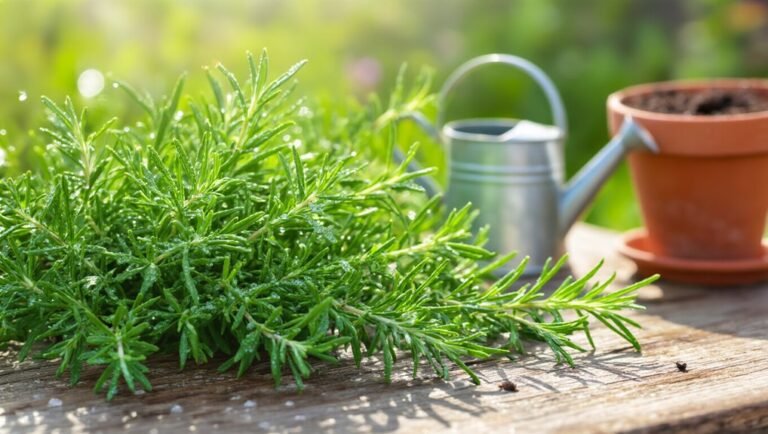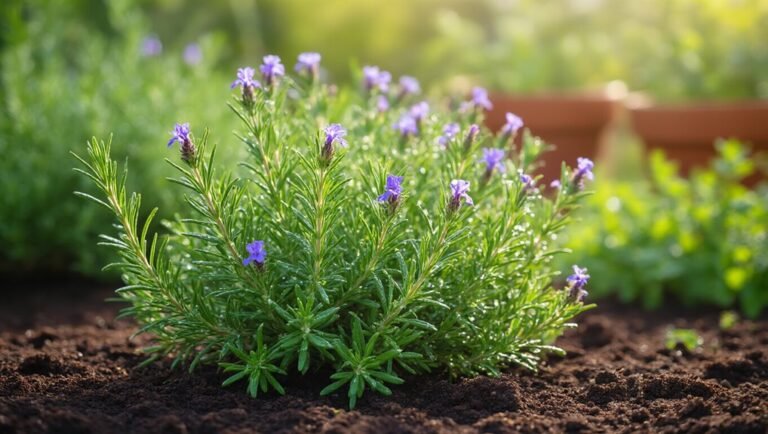If your hydroponic plants are dying, it’s likely due to improper pH levels in your nutrient solution. When pH isn’t balanced, nutrient absorption suffers, leading to deficiencies and stunted growth. Low pH can limit calcium and magnesium, while high pH can cause iron and manganese shortages. Regular testing and adjustments are crucial for plant health. Keep an eye on your system to prevent pH issues, and you’ll discover effective strategies to keep your plants thriving.
Key Takeaways
- pH levels outside the ideal range can hinder nutrient absorption, leading to poor plant health and growth.
- Low pH may reduce calcium and magnesium availability, while high pH can lead to iron and manganese deficiencies.
- Signs of pH imbalance include yellowing leaves, stunted growth, and wilting, indicating nutrient absorption issues.
- Regularly test and adjust your nutrient solution’s pH to maintain optimal conditions for your plants’ health.
- Neglecting pH management can result in nutrient deficiencies, reduced yields, and overall poor plant performance.
Understanding Ph and Its Importance in Hydroponics
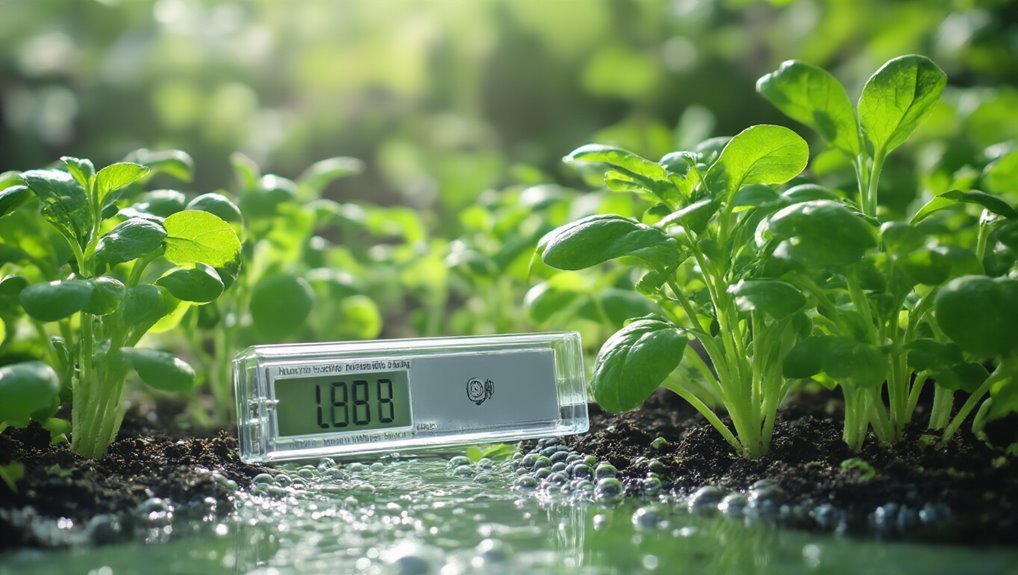
When you dive into hydroponics, understanding pH is crucial for your plants’ health. pH measures the acidity or alkalinity of your nutrient solution, and even slight fluctuations can significantly impact nutrient absorption. If you’re just starting out, choosing the right hydroponic gardening systems can also help you maintain better control over your growing environment.
If your solution’s pH strays too high or low, your plants may struggle to take in essential nutrients. For instance, at a low pH, nutrients like calcium and magnesium can become less available, leading to deficiencies. Conversely, a high pH can cause iron and manganese shortages.
Regularly testing your nutrient solution with a reliable pH meter helps you maintain balance. Adjusting the pH is just as important; use pH up or down solutions to bring it back into the ideal range, ensuring your plants thrive and grow robustly. For optimal results, always pair your monitoring with essential hydroponic nutrient solutions to provide the complete nutrition your plants need.
The Ideal Ph Range for Different Hydroponic Plants
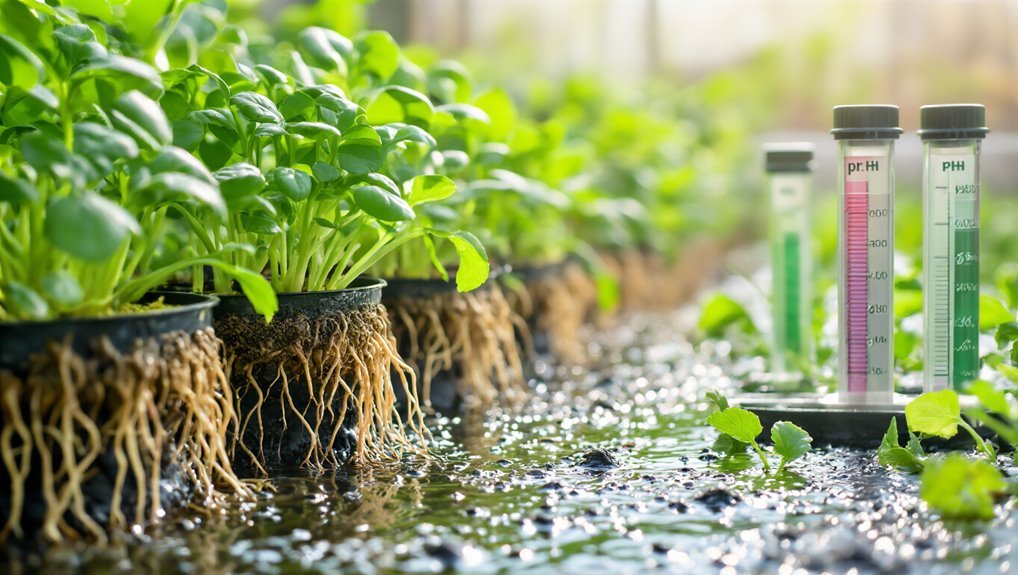
Maintaining the right pH level is key to optimizing your hydroponic setup, as different plants thrive within specific pH ranges. Knowing these ranges helps you ensure your plants get the nutrients they need. If you’re just starting out, herb garden kits with seeds and pots offer a convenient and reliable way to begin your indoor gardening journey. Here’s a quick guide to help you:
| Plant Type | Ideal pH Range |
|---|---|
| Lettuce | 5.5 – 6.5 |
| Tomatoes | 5.5 – 6.5 |
| Cucumbers | 5.5 – 6.0 |
| Basil | 5.5 – 6.0 |
| Strawberries | 5.5 – 6.8 |
Aim to keep your nutrient solution within these ranges to promote healthy growth. Regularly check your pH levels to avoid any issues that could hinder your plants’ development. For best results, consider starting your hydroponic garden with essential seed starting kits to give your plants the healthiest beginning possible.
Signs Your Hydroponic Plants Are Suffering From Ph Imbalance
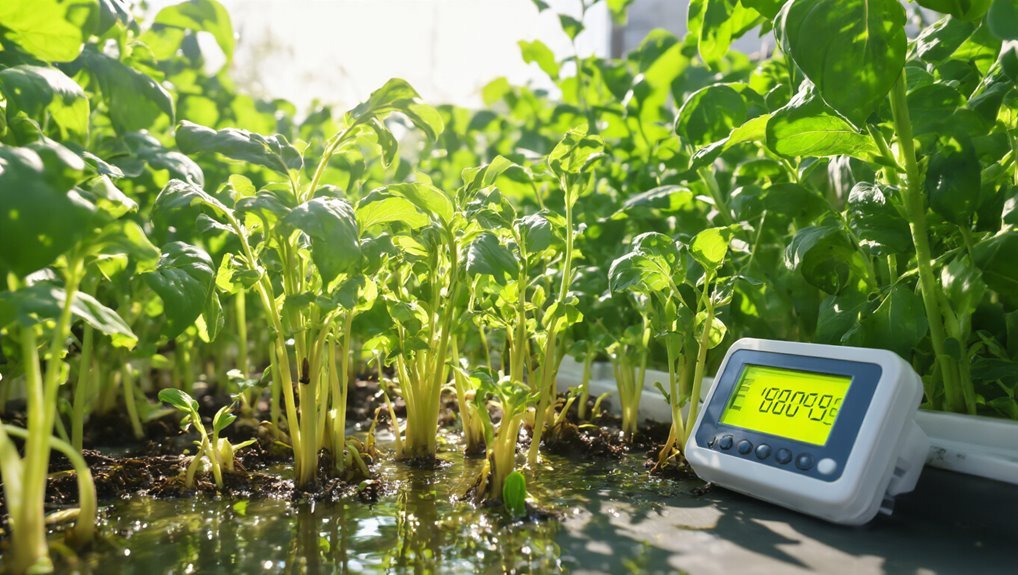
pH imbalance can lead to several distress signals in your hydroponic plants, and recognizing these signs early is crucial for recovery.
If you notice yellowing leaves, particularly on older foliage, it might indicate nutrient deficiencies due to improper pH levels. Stunted growth is another red flag; if your plants aren’t thriving, check your pH. Self-watering planters can help maintain consistent moisture, which supports more stable pH levels in the root zone.
Wilting or drooping leaves can signal that your plants are struggling to absorb water and nutrients. Additionally, brown leaf tips or edges often point to excessive acidity or alkalinity.
Pay attention to any signs of nutrient burn, like crispy leaf margins, which can occur when the pH prevents nutrient uptake. Keeping a close eye on these symptoms can help you take action before it’s too late.
Some gardeners find success by growing insect repellent plants like citronella alongside their hydroponic setups to help manage pests naturally.
Common Causes of Ph Fluctuations in Hydroponic Systems
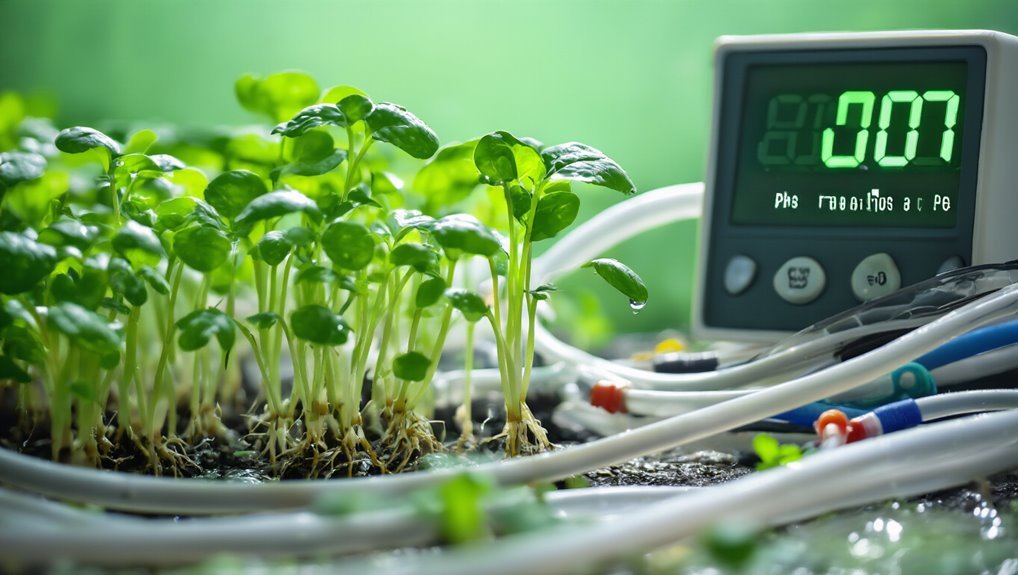
Fluctuations in pH levels can stem from various factors in hydroponic systems, impacting your plants’ health. One common cause is the nutrient solution itself; certain fertilizers can alter pH as they dissolve.
Additionally, the microbial activity in your system can lead to shifts in pH, especially if beneficial bacteria are present. Water quality plays a significant role too; if your water source has a high mineral content, it can affect the overall pH balance. Incorporating a drip irrigation system can help maintain more consistent nutrient and water delivery, which may reduce pH variability and stress on your plants.
Furthermore, temperature changes can influence pH levels, as warmer water can lead to increased evaporation and concentration of nutrients.
Lastly, regular maintenance and cleanliness of your system are crucial; accumulated organic matter can also cause pH instability. For gardeners working with hydroponics or soil, using garden harvesting tools can help maintain plant health and improve overall yields by ensuring clean and precise harvesting practices. Stay vigilant to keep your plants thriving!
How to Test the Ph of Your Nutrient Solution
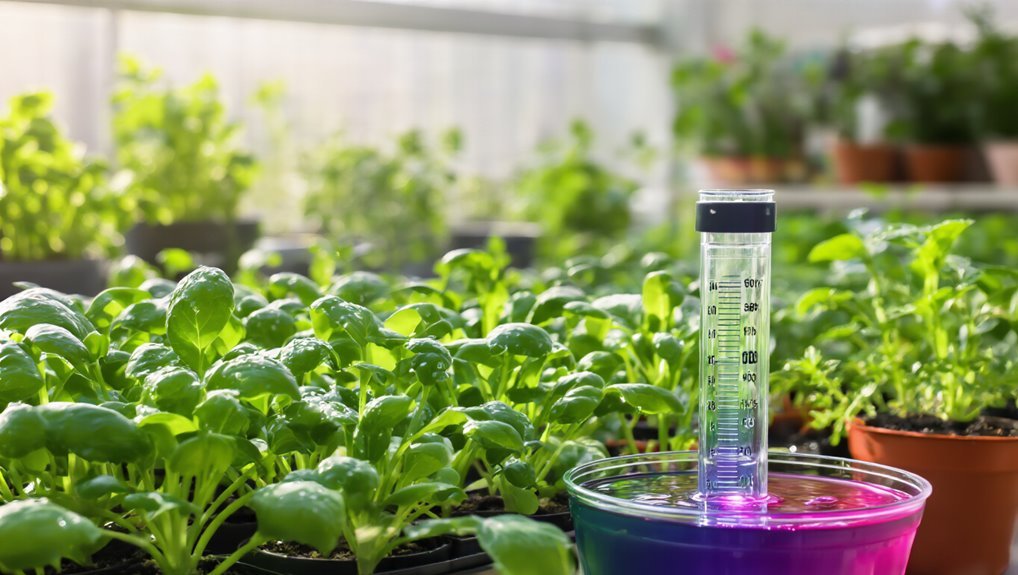
To ensure your hydroponic plants thrive, regularly checking the acidity of your nutrient solution is important.
Start by using a reliable pH meter or pH test strips. If you’re using a meter, calibrate it according to the manufacturer’s instructions to ensure accuracy.
Then, scoop a sample of your nutrient solution into a clean container. Immerse the pH meter probe or dip the test strip into the solution for a few seconds. If you’re using a meter, wait for the reading to stabilize. For test strips, compare the color change to the provided scale.
Record the pH level and repeat this process weekly or whenever you notice changes in plant health. Consistent testing helps you maintain optimal conditions for growth.
Adjusting Ph Levels: Techniques and Tools
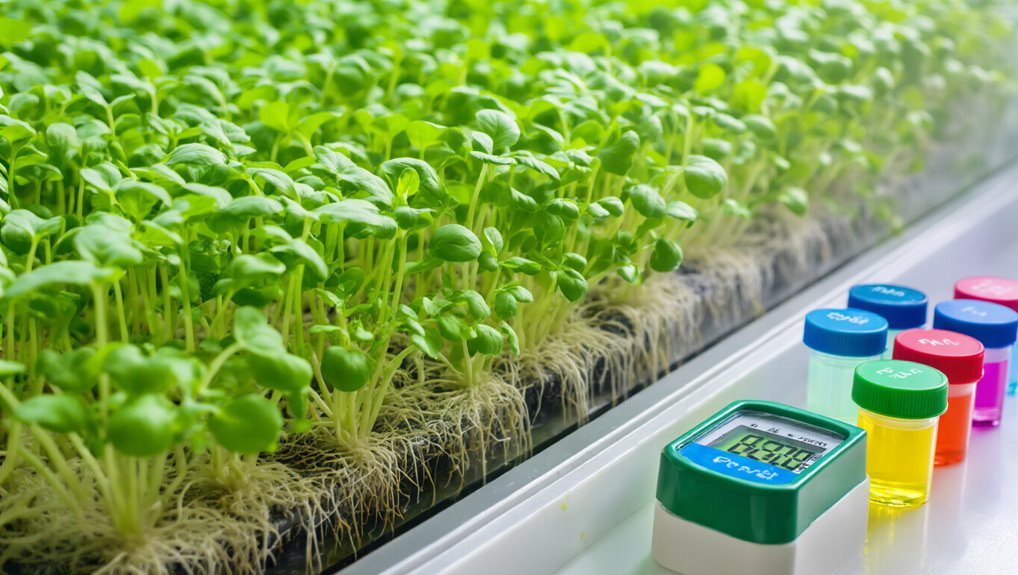
When your nutrient solution‘s pH levels drift outside the ideal range, you need effective techniques and tools to make adjustments.
First, use pH up or pH down solutions, which are readily available at garden stores. Just add small amounts to your solution, mixing well, and retest until you reach the desired level. A pH meter or test strips can help ensure accuracy. Consider investing in a digital pH meter for quicker and more precise readings.
Additionally, regularly monitor your nutrient solution’s pH, as fluctuations can happen rapidly. If you notice frequent changes, check your water source and nutrient mix, as these can impact pH stability.
Keeping a close eye on these factors will help maintain a healthy hydroponic environment.
The Role of Ph in Nutrient Absorption
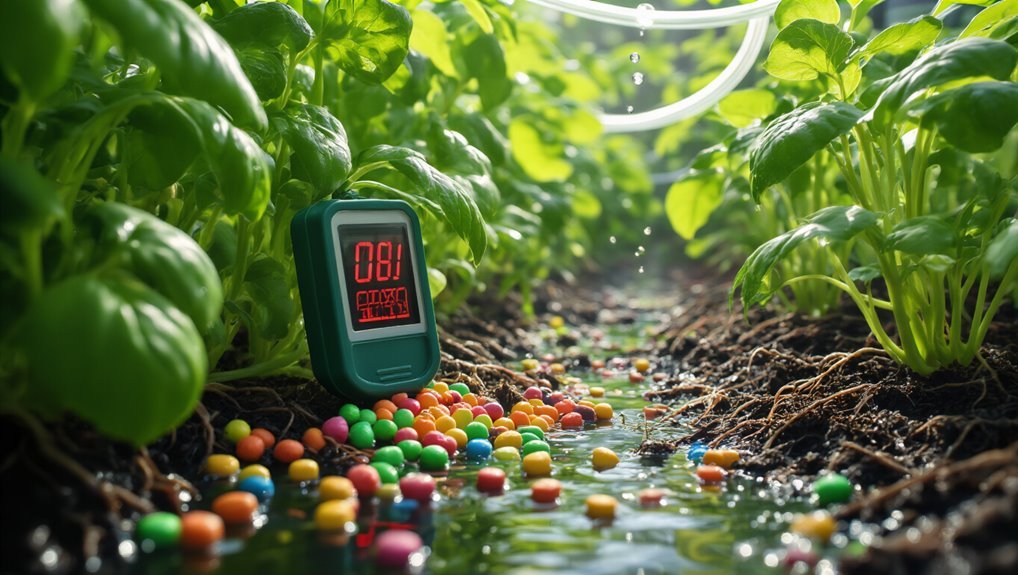
Maintaining the right pH not only stabilizes your nutrient solution but also plays a significant role in how well plants absorb those nutrients.
When your pH levels are too high or too low, essential nutrients can become locked out, making them unavailable to your plants. For example, at a pH above 7, iron and manganese can become less accessible, leading to deficiencies.
Conversely, a pH below 5.5 can hinder calcium and magnesium uptake. By keeping your pH in the optimal range—typically between 5.5 and 6.5—you ensure that your plants can efficiently absorb the nutrients they need for healthy growth.
Regular monitoring and adjustment can help you maintain this balance and support your hydroponic garden’s success.
Long-Term Effects of Ignoring Ph Levels
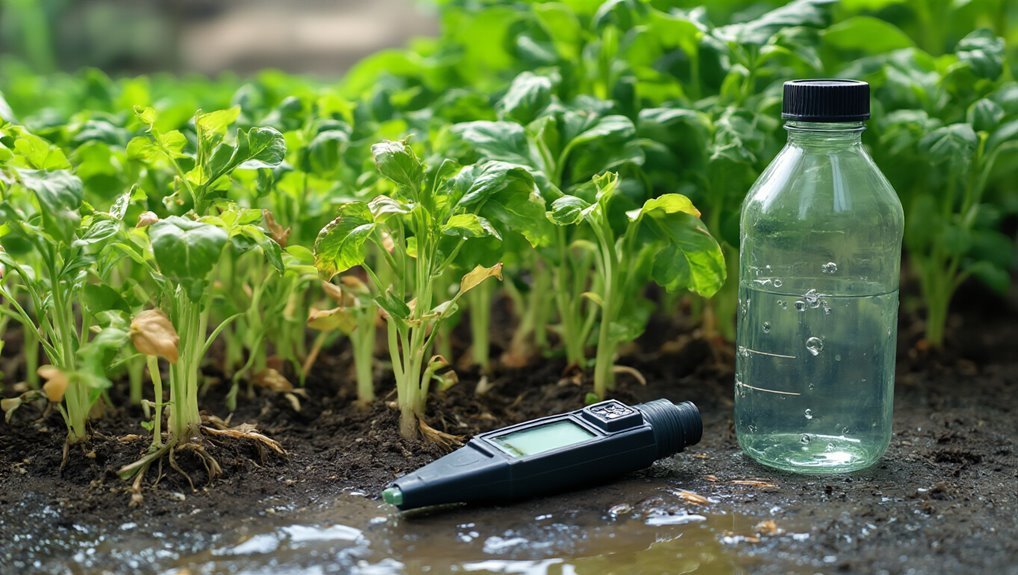
Ignoring pH levels in your hydroponic system can lead to severe long-term consequences for your plants. Over time, nutrient deficiencies may arise, stunting growth and reducing yields. You’ll notice wilting leaves, discolored stems, and overall poor health in your crops.
| Consequence | Description | Visual Impact |
|---|---|---|
| Stunted Growth | Plants can’t absorb nutrients | Short, weak plants |
| Leaf Discoloration | Nutrient imbalances show up | Yellowing or browning leaves |
| Reduced Yield | Less fruit or flower production | Sparse harvests |
If you don’t address pH issues, you’re setting yourself up for failure. Invest time in monitoring your pH levels to ensure your hydroponic garden thrives.
Preventing Ph Issues in Your Hydroponic Setup
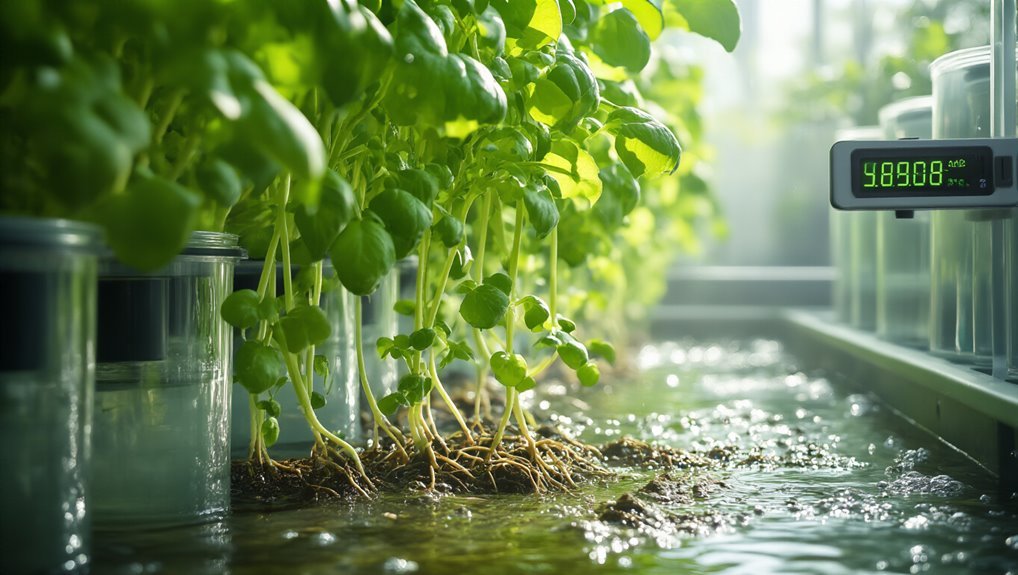
To keep your hydroponic setup thriving, it’s essential to take proactive steps in managing pH levels. Start by regularly testing your water solution with a reliable pH meter. Aim to maintain the ideal range for your plants, usually between 5.5 and 6.5. Adjust pH as necessary using pH up or down solutions, following the manufacturer’s instructions.
Additionally, ensure your nutrient solution is balanced; some nutrients can affect pH levels more than others. Regularly clean your system to prevent buildup that can cause fluctuations.
Finally, consider using pH stabilizers, which can help maintain consistent levels. By staying vigilant and making these adjustments, you’ll create a healthier environment for your plants, promoting growth and reducing the risk of pH-related issues.
Resources for Further Learning on Hydroponic Ph Management
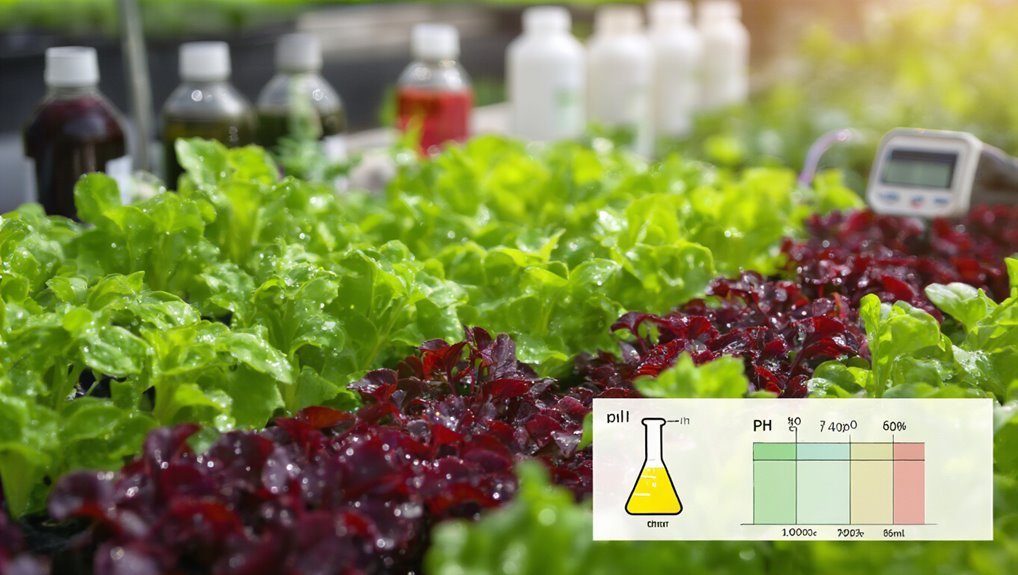
As you delve deeper into hydroponic pH management, you’ll find a wealth of resources designed to enhance your understanding and skills.
Start with online forums and communities where experienced growers share tips and troubleshoot issues. Websites like Hydroponics Simplified and Gardening Know How offer in-depth articles and guides.
YouTube is another excellent platform, featuring tutorials that visually demonstrate pH testing and adjustments.
Don’t overlook books like “Hydroponics: A Practical Guide for the Soilless Grower” for comprehensive insights.
Lastly, consider joining local gardening clubs or workshops to learn from fellow enthusiasts.
Frequently Asked Questions
Can I Use Tap Water for My Hydroponic System?
You can use tap water in your hydroponic system, but check its quality first. Chlorine and other chemicals might harm your plants. If necessary, let it sit out or use a water filter for better results.
How Often Should I Check Ph Levels in My Setup?
Regularly check your pH levels, ideally every week, to ensure your hydroponic system thrives. Consistent care keeps conditions conducive for growth, preventing potential problems. Don’t let pH fluctuations jeopardize your plants’ performance!
What Are the Best Ph Meters for Beginners?
For beginners, look for pH meters that are easy to use and calibrate. Brands like Apera and Bluelab offer reliable options. You’ll want something accurate, portable, and durable to ensure your plants thrive.
Do Temperature Changes Affect Ph Levels in Hydroponics?
Temperature changes in your hydroponic setup can be like a rollercoaster for pH levels. As temps rise or drop, chemical reactions speed up or slow down, affecting nutrient availability and plant health. Keep it steady!
Can Organic Nutrients Impact Ph Balance Differently Than Synthetic Ones?
Yes, organic nutrients can impact pH balance differently than synthetic ones. Organic nutrients often create a more stable pH, while synthetic options may cause fluctuations. Monitoring both types helps you maintain optimal conditions for your plants.
Conclusion
In hydroponics, managing pH is like tuning a musical instrument; if it’s off, the whole symphony of growth can fall flat. Just as a slightly sharp note can ruin a melody, a minor pH imbalance can lead to wilting plants and stunted growth. By keeping your pH levels in check, you’re ensuring your plants thrive in harmony. So grab that pH meter and start fine-tuning your setup—your plants will thank you with vibrant, healthy growth!
